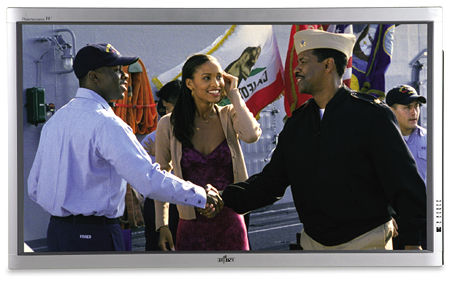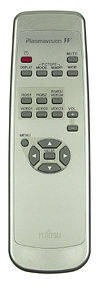Fujitsu Plasmavision SlimScreen P50XHA10US HD Monitor
Ah, plasma. There's nothing sexier in the home theater world. Where else can you get a bright, sharp image without any box to speak of? It just hangs there on your wall and attracts attention like a supermodel walking into your local Denny's.

Like said supermodel, Fujitsu's P50XHA10US is impossibly skinny, just 3.7 inches deep. Its tiny, shiny, silver bezel is barely noticeable surrounding the 50-inch-diagonal screen. That screen is made up of 1,049,088 pixels (1,366 the long way and 768 the short way), which just screams for you to give it some 720p material to display. But you're getting ahead of yourself. Down, boy. First, you have to set it up.
At 99 pounds, the P50XHA10US is lightweight compared with many plasmas, so it shouldn't be a problem to install it on most walls. If your house is made entirely of drywall and particleboard with no load-bearing studs, you can mount it on a stand (the plasma, not your house). On the back are one S-video and one composite input, two component inputs, a computer-style RGB input, and a DVI connection with HDCP. Once you get your connections sorted out, you can power up and be blinded by the light.
Out of the box, the Fujitsu is certainly bright; its "torch" settings seem to be the default. This will certainly impress the neighbors (they should be able to see it through the walls of your house), but it doesn't bode well for the set's longevity. To remedy the situation, there are five video presets to play with, most of which will blow you out of the room with way too much light output. The fine setting is perhaps the most accurate, and it's one of the few settings that doesn't float the black level (the other two being the real2 setting and, to some extent, the static setting). In the remaining settings, it's very hard to see any detail in the darker portions of a bright image. This makes the image really jump out, but it can be distracting with film-based or other high-contrast sources. Using Video Essentials or a similar setup DVD, you should be able to adjust the rest of the picture parameters to your liking with little difficulty. Depending on the mode you choose, there may be some edge enhancement, which you can easily defeat using the sharpness slider in the video menu.
You perform all of these operations using a rather bland-looking remote. Although it's not backlit, the remote is very easy to use. It has discrete input buttons and a picture-mode button that lets you sort through the presets quickly. In addition to the discrete video settings for each input, there's also a button to scroll through the eight additional memories for your own video settings. Perhaps the coolest button is the display button, which provides information about the signal you're watching. It's not vital to operation, but it's cool nonetheless. The wide button changes the display's aspect ratio. This works well; however, with HD signals, it will only zoom in slightly and doesn't give you full control. This is disappointing but not crucial. Press the input button that corresponds to your HD source, and you're off.

Performance-wise, the first thing I noticed about the P50XHA10US was its detail level. Although it's "only" a 720p display, it looks far sharper than you'd expect. Watching a documentary in HD on the local PBS affiliate, I was struck by the sharpness in the flowers and other vegetation (aren't documentaries exciting?).
This brings me to the Fujitsu's next strongest attribute: its color. An extremely accurate color decoder processes the image well, with no red push. The plasma's color points exceed those specified by SMPTE. In some displays, this can lead to cartoonish, oversaturated colors, but not here. The Fujitsu's colors were extremely vibrant but never too crazy. Foliage and shrubbery were green like a PGA Tour fairway.
 After setup, the image wasn't as bright as it was out of the box, but it was far more accurate. The image's bright portions still popped, though. This is fairly common for a plasma. The full-panel light output is far less than what's possible when only a portion of the image is bright. Think peak versus sustainable power from an amp. In this case, the peak output in a smaller window was about twice what the entire panel could sustain. Some images caused the display to crush the whites a bit. You know what that means. . .test pattern time.
After setup, the image wasn't as bright as it was out of the box, but it was far more accurate. The image's bright portions still popped, though. This is fairly common for a plasma. The full-panel light output is far less than what's possible when only a portion of the image is bright. Think peak versus sustainable power from an amp. In this case, the peak output in a smaller window was about twice what the entire panel could sustain. Some images caused the display to crush the whites a bit. You know what that means. . .test pattern time.
A handy copy of Video Essentials started off the DVD tests. Although it didn't show up on all of the test patterns, each of the Fujitsu's video modes crushed whites, no matter how I set up the display. This wasn't nearly the problem I thought it would be, though. With regular video material, I hardly noticed it.
Title 18, chapter 6 of Video Essentials reveals a gray ramp. The left side of the screen is fully white, the right side is black, and every level of gray you can imagine falls in between. Analog displays like direct-view CRTs have no problem with this pattern. Almost all digital displays, especially plasmas, do have trouble. Instead of a smooth transition from light to dark, there are noticeable steps in the gray. In the borders between these steps, you'll see video noise, as the video processor can't figure out what to do with the transitions. The Fujitsu's test performance was about average. The steps were just noticeable, with only a slight amount of noise in the borders. Again, with regular video material, this wasn't that obvious. In chapter 5 of The Fifth Element, Bruce Willis bolts upright in bed. On a lesser display, the area behind his brightly lit head would solarize and produce the noise I described above. The Fujitsu handled this in stride with very little artifacting.
Highlights
• Beautiful color
• Excellent detail









































